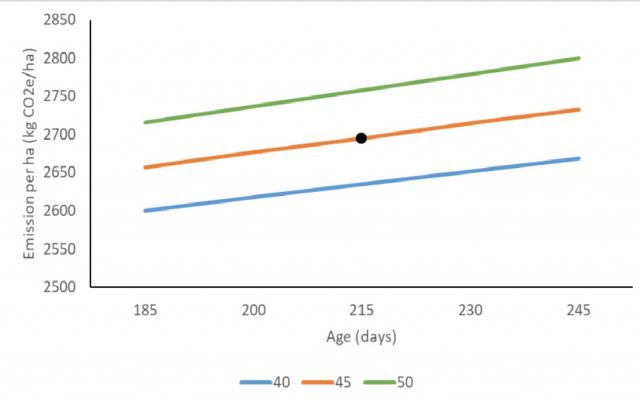Katanning Research Station Case study
Katanning Research Station runs a self-replacing merino sheep flock of around 1000 breeding ewes. The top 90% of ewe lambs are retained to top up research flocks or remain in the commercial flock, and all wether lambs are sold.
This flock has been used to model different weaning and turn-off rates, and the effects these changes can make on total greenhouse gas emissions and emissions intensity. In 2022, the commercial flock had a weaning rate of 113%, and an average turn-off weight of 44kg at 215 days old. The growth rate from weaning was 160g/hd/day. The total emissions for this flock was estimated to be 522 tonnes of CO2e with an emissions intensity of 7.3kg CO2e/kgLW.
3 efficiency scenarios
Strategy 1: More efficient lamb production
For every 10% increase in weaning rates, there is a reduction of ~2-3% in emissions intensity (Figure 1). The scenario added 1% to the sheep enterprise's total emissions per 10% improvement above the 100% weaning rate.
Strategy 2: Run fewer ewes whilst maintaining productivity
To reduce total GHG emissions the number of ewes need to be reduced. If weaning rates were increased from 110% to 120%, (ie an additional 100 lambs from 1000 ewes joined), the number of ewes could be reduced to 917 to maintain the 1100 total lambs weaned.
This reduces the total carbon emissions by 9%, or 37 tonnes of CO2e, which is equivalent to 1 person travelling return from Perth to London 10 times.
This is in addition to the gains made in carbon intensity from improving weaning rate - giving a total emissions reduction of ~8%. This figure is taking into account the increased total emissions from producing more lambs.
Strategy 3: Grow lambs quicker and sell them younger
Total emissions increase with increased turn-off age at liveweight due to the extra days on the farm (figure 2a). Similarly, emissions intensity also increases with increased turn-off age, however, having heavier lambs at the same age by improving efficiency and growing them more quickly, emissions intensity is reduced (figure 2b).
By turning-off lambs 5kg heavier at the same age, emissions intensity can be reduced by 2.7%.
Co-benefits to reducing greenhouse gas emissions
- Reducing reproductive wastage – more lambs to sell
- Higher genetic turnover and improved genetic selection
- More effective use of supplementary feeds and pasture allocation.
- Access to premium markets through low emission produce.
Ways to improve efficiency
- Nutrition – Ewe nutrition during joining, lambing and lactation improves lambing rates and lamb survival as well as increasing liveweight and lowering turn off times of lambs
- Lamb survival rates – good nutrition, time of lambing, improved pasture, and providing shelter for twin-bearing ewes is key to increased productivity.
- Genetics – Using the Australian Sheep Breeding Values (ASBVs) definitions when selecting rams for reproductive and sustainability traits (eg. feed efficiency) and, eventually, methane production/yield).
- Good animal welfare –Improving the health and welfare of animals (use of pain relief at marking, right vaccinations at right time) will improve the quality and profitability of livestock.
- Pregnancy scanning – removes unproductive ewes that emit methane for no productivity gain.
Risks of reducing methane emissions through managing sheep reproduction
- Selecting animals purely on their methane emissions can lead to selecting sheep that have reduced feed intake and therefore reduced production.
- Just lowering emissions intensity of your enterprise may not lead to reduced total emissions, which is important if your goal is to achieve carbon neutrality at the farm business level.
- More intensive management may lead to greater indirect emissions from inputs such as fuel and fertiliser use.
Authors: Mandy Curnow, Sud Kharel and Claire Macleay



